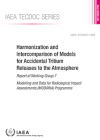Air pollution is generally caused by industrial, agricultural and other anthropogenic (human) activities. The IAEA studies the natural processes that influence the pollutants’ global spread and their deposition rates on land and sea, to understand how they interact with weather patterns and how to mitigate their effects.
Air pollution
Common pollutants that are of particular concern to the IAEA because of the impact they have on the environment and public health include heavy metals like lead; greenhouse gases, such as carbon dioxide and methane; and radioactive gases and particles. The Agency uses isotopic and nuclear tools to monitor their pathways through the atmosphere, predict their distribution and estimate their impact on ecosystems.
The effects of greenhouse gases
Carbon dioxide and methane generated by industry and agriculture concentrate in the atmosphere and cause it to increase the absorption of infrared radiation warming up the atmosphere. This is commonly called the “greenhouse effect.” Some models predict that this warming is leading to changes including increased climatic variability and extreme weather conditions, such as floods and droughts. The full impact of high carbon dioxide concentrations in the atmosphere, however, is still uncertain.
Scientists use isotopes to study historical records, such as ice cores, to try to understand what the world was like under past temperatures and carbon dioxide concentrations. This in turn helps them predict future scenarios.
Using the isotope ratios of carbon, oxygen and hydrogen in carbon dioxide and methane, the IAEA can fingerprint the source and monitor the pathways of greenhouse gases in terrestrial and marine environments. This technique has found evidence of emissions caused by human activity in the most remote places of the planet. The measurements obtained through these experiments can be used to develop atmospheric models to monitor and predict changes to the global carbon cycle and climate.
The IAEA shares with its Member States research results and acquired knowledge, and provides them with training and reliable reference materials that can be used to calibrate instruments to precisely measure greenhouse gases. The Agency also makes available international stable isotope reference materials for carbon, oxygen and hydrogen.
Monitoring radionuclides in the atmosphere
Radionuclides in the atmosphere rapidly attach to minuscule aerosols. Their variability (range of possible changes) in ground-level air is driven by the behaviour of these aerosols. Understanding these processes helps scientists evaluate and predict the movement of pollutants worldwide. This is particularly useful to assess and mitigate possible impacts of accidental releases of radionuclides from nuclear installations.
The IAEA’s environment laboratories use large volume pumps and collectors to concentrate aerosols and capture dry deposition to determine the quantity of detectable radionuclides in the atmosphere and to monitor variations in their deposition. They also use marine sediment traps to study the impact of atmospheric fallout to the composition of sinking particulate matter in the oceans.
To better understand processes in the lower troposphere and how contaminants are transferred from the atmosphere into terrestrial and marine environments, IAEA experts study the fluxes of radionuclides, such as beryllium-7, caesium-137 and lead-210. These are either produced by cosmic rays (cosmogenic), by human activities (anthropogenic), or occur naturally on earth. Beryllium-7, for example, occurs naturally. Its production rates in the atmosphere are relatively constant, which helps identify processes in the atmosphere that influence the deposition of this radionuclide on earth. In this way, it can be used as a tracer.





